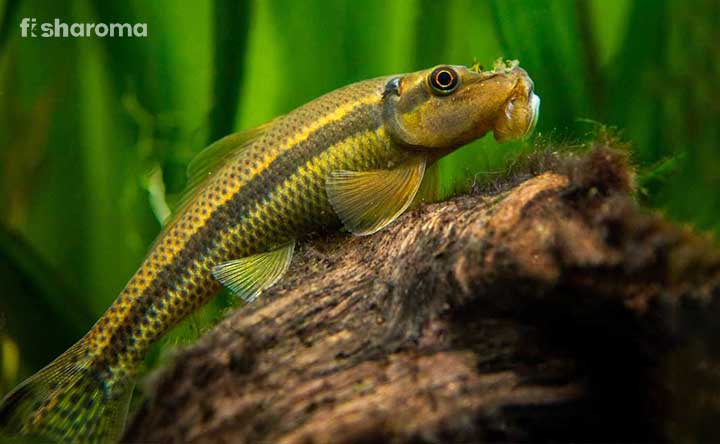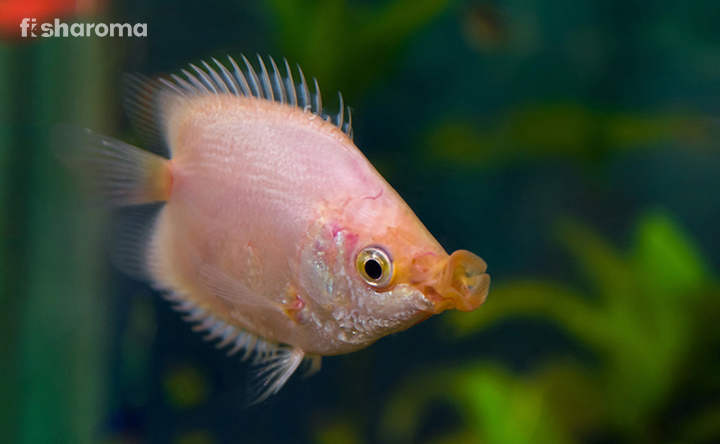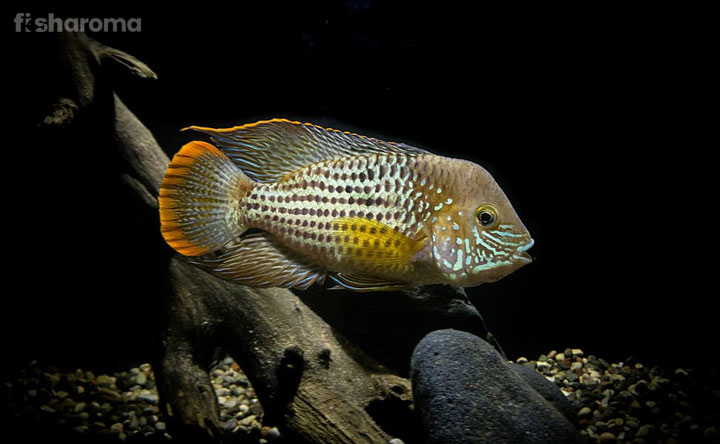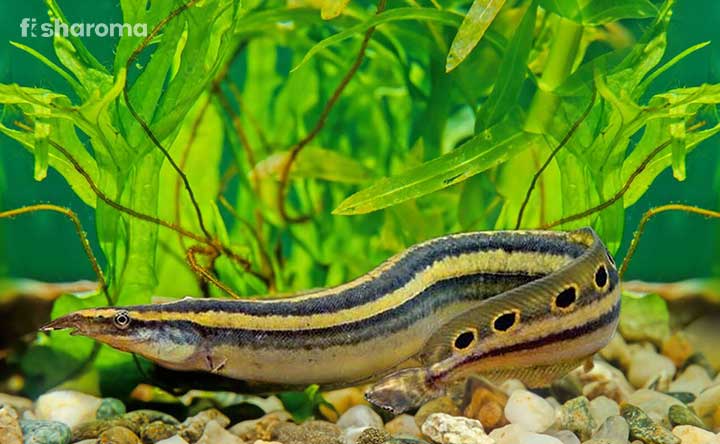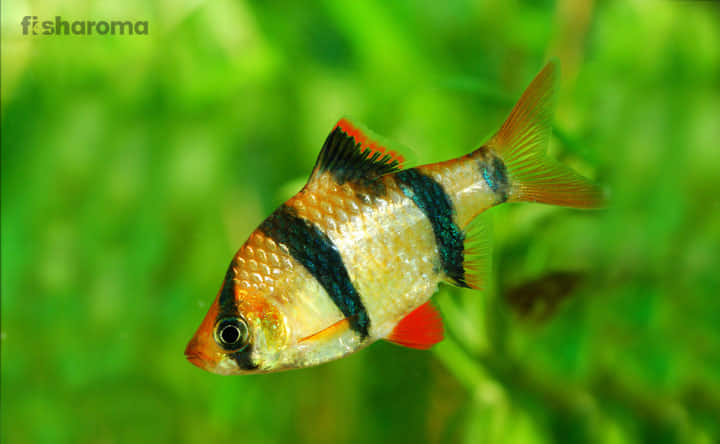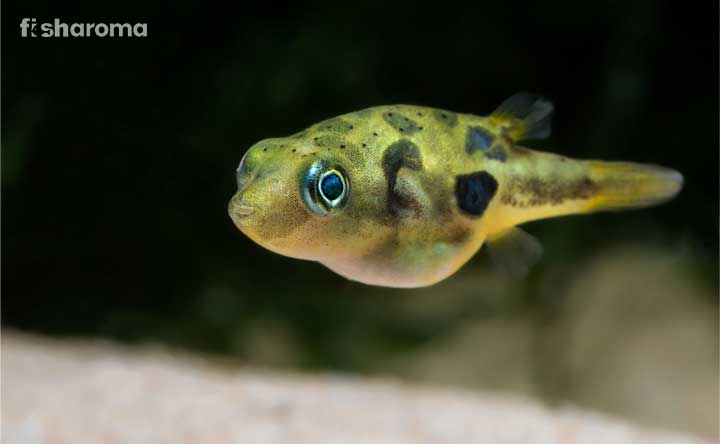Bluefin Notho – The Colourful Killifish That You Would Want To Own
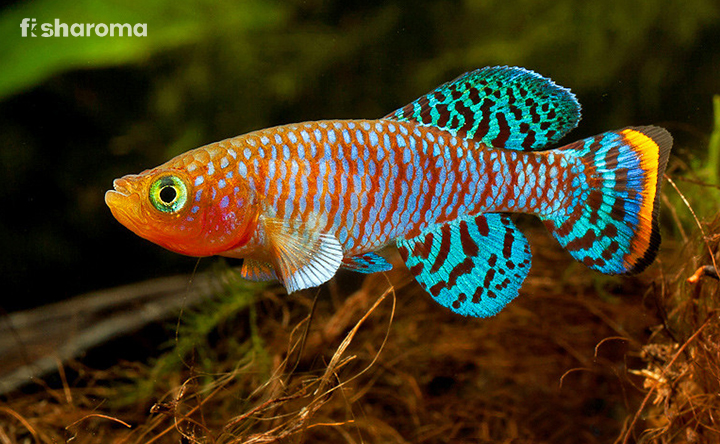
- Origin And Habitat of Bluefin Notho
- Appearance Of Bluefin Notho
- Behaviour Of Bluefin Notho
- Lifespan Of Bluefin Notho
- Diet Of Bluefin Notho
- Tank Requirements Of Bluefin Notho
- Water Type For Bluefin Notho
- Compatibility Of Bluefin Notho
- Breeding Of Bluefin Notho
- Diseases And Treatments of Bluefin Notho
- Summary
The Bluefin Notho, with a spectacular appearance, has made its way directly to our house. The popularity has become so much that professional breeders have taken up the responsibility to nurture the species. This is also because of the growing demand for the Bluefin Notho and breeders only ensure that we are getting the beautiful fish for our aquariums, just as per our requirements.
This is actually a ray-finned fish that joins many others in the same vast category. So, by now, you have understood that the fish is a darling species to aquarists, and we will now divulge what it takes to be the owner of the colourful species.
Key Specifications Of Bluefin Notho
| Origin | Africa |
| Lifespan | 1 year |
| Colours | Orange, blue, cyan, and yellow |
| Temperament | Gentle |
| Size | 1.9 -2.4 inches |
| Diet | Carnivorous |
| Reproduction | Egg laying |
| Maintenance Requirements | Easy |
| Tank Size | 10-15 gallons |
Overview
The moderately small fish has been a captivating species, due to its colourations. The fish owes its popularity to its undemanding traits along with its gentle nature. Not to forget, the easy and fuss-free maintenance play a crucial role, in making the fish a popular choice for aquarists.
There is another reason that many of you can relate to and that is none other than the space problems. Many fish enthusiasts have to deal with nano tanks because they can’t arrange for bigger tanks. For them, this fish is an ideal option. The short-lived fish, scientifically identified as Nothobranchius rachovii, is no less than an exotic pet, all thanks to its stunning appearance.
Origin And Habitat Of Bluefin Notho
The species is distributed throughout the Pungwe River and Zambezi River. Geographically, the fish is also available in the Kwa Kwa River and Beira of Mozambique. Many people think that as per their topographical differences, they have many colour variations, while some fishes are darker and some have the same shades in lighter houses.
The habitat of Bluefin Notho consists of lowland water bodies like ponds and swamps. The waters are often dried up during the summer and it again fills with water when rain hits the ground. The small fishes can even be found on semi-deep animal footprints where there is little water.
This is at par with the typical African weather and climate and such fishes are accustomed to living in such water depressions that have water for a fleeting time.
Appearance Of Bluefin Notho
The fish with its vivacious shades attracts everybody in its surroundings. Male and female fishes are different from each other, both in terms of the size and shape of their bodies. The fishes have an upturned mouth, which is a typical identifying mark of the species.
Size
The size of the wild and tank-bred fishes are different. This is because the water condition of the aquarium plays a role in the size of the fish. The wild ones are around 2.4 inches in length. The tank bred ones are not that long, rather they are a maximum of 1.9 inches. Male fishes are visibly bigger than the female Bluefin Nothos.
Colour
The fish presents a cluster of colours where there are dual shades of orange and red, acting as the base or main body colour. The entire body has luminous shades in blue, in itsy bitsy patterns that are initially small but the blue patterns get extended on the tails and fins. The ray fins of the fishes have that brightly coloured blue and orange combination.
The female fishes showcase less vibrant colourations than male ones. They have the hues, but their overall colour combination is paler with yellow as a predominant shade. Female fishes also exhibit more or less a transparent fin with some blue tints covering the edge of the fin. Both the genders have dark yet prominent yellow eyes, complementing their iridescent shades.
Behaviour Of Bluefin Notho
The fish tends to be extremely active, more so, because the way it moves its pectoral fins is extremely fascinating. The fish is usually calm and composed, apart from their breeding time, which is excusable. Multiple male Bluefin Notho can sport some territorial aggression, but that is limited to their own species only.
Otherwise, the fish doesn’t give any such problem as it prefers minding its own business. There is nothing to worry about because the fish doesn’t have many tantrums to throw. If it gets timely food, and proper water condition, it will highlight the exquisite shades of their body by beautifully swimming around the water.
There is nothing much extraordinary about their behaviour that we can mention anymore. Just consider this as a peace-loving creature, that grace the freshwater of Africa.
The fish dwells or rather swims in the lower region of the tank, so choosing an appropriate substrate is really important.
Lifespan Of Bluefin Notho
They are often called the annual Killifish because they live for only a year. It is their standard lifespan and there has not been a single case reported where any specific species has lived for exceptionally long life.
Diet Of Bluefin Notho
The fish is actually a carnivorous species and feeding them is not a problem because they can accept both live and frozen foods. The aquarists need to keep one thing in mind, and that is the fish has a good metabolism rate and a small mouth. Read on to know what do they really consume as far as their regular diet is concerned.
This might sound like an odd combination, but its is tricky to maintain because they can eat as much as you can give because they can digest well. Still, there is something called overfeeding, and they can be overfed easily at the same time.
Their mouths are small so they are prone to choke on foods. So, you have to give them foods, multiple times a day, preferably 2-3 times per day and that should be in small quantities. This way you can satiate their food requirements without risking their life.
We recommend live foods because they are more protein enriched, and have all the nutrition that they need for good health. This is more important for female fishes, because their egg-laying frequency is tremendous, and when optimal, they can lay eggs every day. This is why ensuring that the calcium is sufficient in their diet for smooth breeding is necessary.
Some breeders give dried foods at times, some even make them the staple, but not all fishes are enthusiastic about consuming them on a regular basis. Brine Shrimps, mosquito larvae, Daphnia, Grindal Worms, White worms, Cyclopes are good options. Flakes are also good, but nothing is better than live foods for this active fish.
Tank Requirements Of Bluefin Notho
The Bluefin Notho doesn’t need anything that you can’t provide. Here we are mentioning some simple water conditions that are favourable for the growth and thriving of the species. In this article, you can get ideas about how to set up the fish aquarium for the Notho Fish.
Tank Size
Although a single fish can easily fit inside a 5-gallon tank, we never recommend that, nor do we endorse the fact. There are reasons behind this because, firstly, it is never okay for any fish to do with the bare minimum. Secondly, the fish might be swimming freely inside the tank, but it has to stay alone, as more fishes would make the nano tank cluttered and clumsy. Therefore, it is always better that you keep a big tank, not a gigantic one, but a moderately sized one, like 10-15 gallons of tank.
This is a community fish, so, you have to keep some extra space for other fishes as well. No fish, regardless of its species, should be allowed to feel the stress that comes with the constricted place. The community of fishes make the group members secure and happy. Those are a must-have, and there is no exception for these fishes either.
Since we have talked about how the fishes are not to be kept alone, are you wondering about which fishes can cope up with such Killifish species, and share the tank together? We suggest, you wait a little longer and get through our compatibility section exclusively.
Tank Lid
Lid is important because the fish can instinctively jump from the tank for transporting to other water bodies nearby. This is a natural tendency because, in the wild, they need to transfer themselves to better places, where they can get sufficient water. This might be the reason why you should adjust a lid properly without fail.
Ensure from your end that there is enough space between the tank water upper level and the lid because if the fish jumps, it might hurt itself against the lid.
Substrate
The substrate should be covered with peat or something similar that can give a dark appearance.
Filter
The tank should have a filter to clear out all the rotten food particles along with any other dirty stuff. It is to be noted that the filter should maintain an extremely slow water motion, that is almost as good as the motionless or still water body. If the filter can’t do that and produces high flow, that could be detrimental for the fish, because they have to adjust with the speed of the water by going out of their comfort zone.
You can opt for the Air-driven Sponge Filter, as that can be effective enough for both the purposes of filtering the water at the same time maintaining the water flow.
Ornaments
The tank should be decorated in a planned way so that there is no problem for the fishes. Incorporate things like bogwoods, rocks, and leaf litters so that they can contribute to the setting of the dark substrate as well. There might be some roots or any aquatic decorative things that might be offering some hiding destinations for the fishes.
Lighting
The lighting has to be smooth enough so that they don’t harm the fish. There is one more thing that is associated with the lighting factor and that is the brightness. If the lights are exceeding the intensity of it more than 4500K then it might induce the natural jumping tendency of the fish. This is because whenever the heat is too high, the water dries up and the fishes change their habitat by jumping. So, that natural streak is prevalent in their tank condition as well.
Presence Of Flora
More the plants, better the chance of getting the lights into a smoother zone, as the leaves and stems of the aquatic plants will lessen the brightness. Java Fern, Dwarf Sagittaria, Java Moss, Ludwigia, and Cabomba are good ideas for keeping the tank densely planted. You can keep rooted plants in thick ways as well, so that they can create the darkness required for the fish.
Cleaning Method
The cleaning procedure is a must one, and it should be done with great expertise. We are not scaring any new or beginner aquarists, but massive water change, irregular cleaning patterns can only result in harassment of the fishes.
We are making it simple for you, just do the partial water change every week, and the cleaning should be done on the same frequency. The plants that you are keeping should be trimmed occasionally, (Because there is a difference between heavily planted tanks and tanks cluttered with plants).
Even if there are any artificial objects that you are keeping inside the tank, for the enhancement of the aquarium and the fish, you need to make them clean as well.
If the tank starts to gather some dirt and other unwanted objects around the corner, or any dust deposits on the leaves are there, those need to be immediately cleaned. Otherwise, they can effectively be bad for the fishes’ health.
Water Type For Bluefin Notho
The Bluefin Notho majorly belongs to warm weather conditions, so much so that the water is often on the verge of drying up. But that is not all, the fish witnesses a lot of temperature dip as well. As an owner or aquarist, you have to ensure that your fish gets everything that could make them familiar.
Temperature
The Bluefin Notho is exposed to both warm and cool weather, and that is often due to sudden fluctuations of temperatures. In their wild region, they are good enough to survive 16 Degrees Celsius and that can extend up to 32 Degrees Celsius.
But for a homely tank set-up, you have to adjust that range a bit more. It would be better if you can keep the range within 20-24 Degrees Celsius. If you want to go a little advanced with the fish care, then maintain an ideal 23 Degrees Celsius. Since warm weather triggers the growth of the species, and the fish has an overall short lifespan, so, this way you can ensure their stable growth and have the company of the fish for more days. Although there is no specific proof that can back this up, this is a common belief that many breeders try to maintain.
pH Level
The fish needs acidic water that is generally on the borderline of being alkaline as well. The standard range is 6-7.5. Get that exact range for your room aquarium, housing Bluefin Notho.
Hardness
The general hardness of the water should be 3-20 dGH.
Compatibility Of Bluefin Notho
The fish has a spontaneous jovial temperament and that is applicable for almost all fishes belonging to the same species. It is not difficult to handle the fish because they can deal with a lot of fishes inside the tank and that too, peacefully. They can also be kept together with their very own group and they are not going to mess up, if you maintain the male and female numbers, in a proper way.
Suitable Tank Mates
The trick of figuring out the right tank mates is to find out fishes who require the same water parameters just like the Bluefin Notho. The size of the fish should also matter because often the larger fishes disturb the smaller ones. The ideal tank mates are other types of KIllifishes that go well with the fish. Apart from these, you can try
Unsuitable Tank Mates
Don’t go for any fishes that are ambush predators and who can attack the Bluefin Notho. A male Bluefin Notho often becomes territorial and show aggression within their own genders so it would be wise on your part, not to opt for multiple males inside a tank.
Even if you house them together, then make sure the tank is large enough to accommodate all, along with lots of plantations. So. that they can’t see each other frequently and even if they can, they have their own space to stay within.
Breeding Of Bluefin Notho
Their short lifespan implies that their life cycle happens fast and it is a challenge for the breeders to breed the species before their time runs out. Ideally, one male should be placed with multiple females and there should be enough peat substrate.
The male fish starts attracting the female fish for mating, by showcasing the colours of the body. When a female is attracted then it takes a plunge into the deep peat substrate. The mating and spawning happen and the male starts fertilizing the eggs, once they are laid. The fry comes out after a few days and they attain sexual maturity within 3 weeks. Their colours and other dimorphic features will be fully developed within 1.5 months of their birth.
The fry or the baby fishes can be given Brine Shrimps, that too freshly hatched ones for their well being. These juveniles are to be kept under proper supervision because they are prone to get attacked by a lot of bacteria or even parasites.
Diseases And The Prevention Of Bluefin Notho
The fish can get seriously ill if you give it improper foods, that too in large quantities. They can have serious digestive problems. Apart from this one, there are some serious issues like freshwater diseases like fin rotting, dropsy (stomach inflammation), mouth fungus, fish fungus, fish lice, swim bladder diseases, ammonia poisoning, and many more things.
There are many preventive measures that you need to follow. This will allow the fish to have a healthy life. This includes proper cleaning of the tank, the food should be clean and free from all sorts of parasites. You just have to ensure the basic care level from your end, so that your fish can stay healthy.
Summary
The small yet spectacular fish, comes in a beautiful combination of multiple shades. Those are contrasting yet complementing in an aesthetic way. The nature of the fish is equally good and easy to deal with. You don’t have to worry about their requirements, especially if you are a first-time owner, because they need a pretty basic carnivorous diet and water conditions.
They are not solitary fishes, demanding to be separately treated. You can keep them in community or school, not only with their own group, rather with other fishes.
Other Similar Care Guides
We have thoroughly enjoyed talking about the colourful Killifish, and hope you have a good time reading about that as well. There are other fishes, in the freshwater category, whom you can pet with fun. They are sure to give you good company.
- Black Ruby Barb – The Sri Lankan species has a beautiful shade of black and red combined together. This is more prominent in male fishes, especially when they are about to mate.
- Kribensis Cichlid – The rainbow-coloured fish is a sight to die for and it is a freshwater species. The care guide of this fish is given in detail so that prospective owners find it easy.
- Black Phantom Tetra – This is one of the most conspicuous Tetra fishes, and it comes with a grayish tint all over its body. This omnivorous species is a social one by nature and can be kept in a community fish tank.



